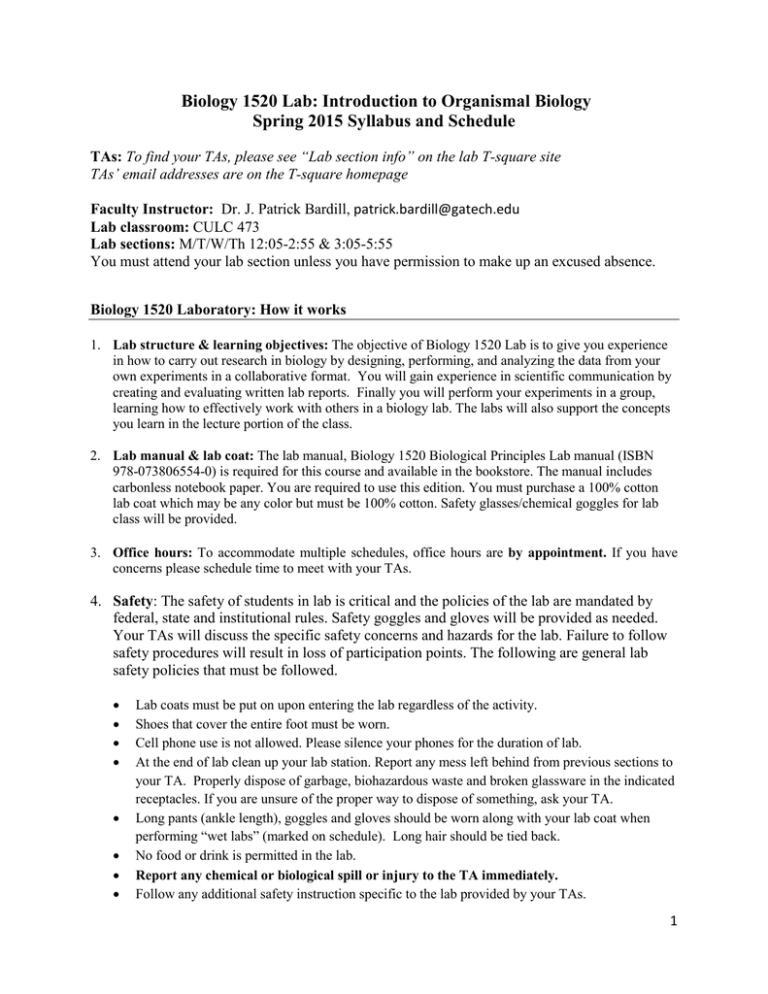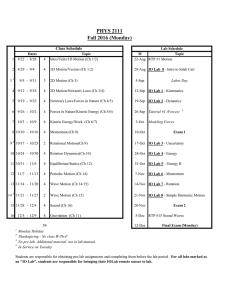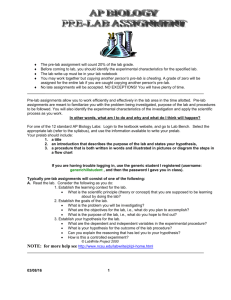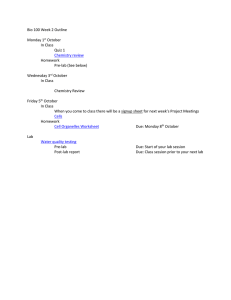Syllabus Lab - Georgia Tech
advertisement

Biology 1520 Lab: Introduction to Organismal Biology Spring 2015 Syllabus and Schedule TAs: To find your TAs, please see “Lab section info” on the lab T-square site TAs’ email addresses are on the T-square homepage Faculty Instructor: Dr. J. Patrick Bardill, patrick.bardill@gatech.edu Lab classroom: CULC 473 Lab sections: M/T/W/Th 12:05-2:55 & 3:05-5:55 You must attend your lab section unless you have permission to make up an excused absence. Biology 1520 Laboratory: How it works 1. Lab structure & learning objectives: The objective of Biology 1520 Lab is to give you experience in how to carry out research in biology by designing, performing, and analyzing the data from your own experiments in a collaborative format. You will gain experience in scientific communication by creating and evaluating written lab reports. Finally you will perform your experiments in a group, learning how to effectively work with others in a biology lab. The labs will also support the concepts you learn in the lecture portion of the class. 2. Lab manual & lab coat: The lab manual, Biology 1520 Biological Principles Lab manual (ISBN 978-073806554-0) is required for this course and available in the bookstore. The manual includes carbonless notebook paper. You are required to use this edition. You must purchase a 100% cotton lab coat which may be any color but must be 100% cotton. Safety glasses/chemical goggles for lab class will be provided. 3. Office hours: To accommodate multiple schedules, office hours are by appointment. If you have concerns please schedule time to meet with your TAs. 4. Safety: The safety of students in lab is critical and the policies of the lab are mandated by federal, state and institutional rules. Safety goggles and gloves will be provided as needed. Your TAs will discuss the specific safety concerns and hazards for the lab. Failure to follow safety procedures will result in loss of participation points. The following are general lab safety policies that must be followed. • • • • • • • • Lab coats must be put on upon entering the lab regardless of the activity. Shoes that cover the entire foot must be worn. Cell phone use is not allowed. Please silence your phones for the duration of lab. At the end of lab clean up your lab station. Report any mess left behind from previous sections to your TA. Properly dispose of garbage, biohazardous waste and broken glassware in the indicated receptacles. If you are unsure of the proper way to dispose of something, ask your TA. Long pants (ankle length), goggles and gloves should be worn along with your lab coat when performing “wet labs” (marked on schedule). Long hair should be tied back. No food or drink is permitted in the lab. Report any chemical or biological spill or injury to the TA immediately. Follow any additional safety instruction specific to the lab provided by your TAs. 1 5. Absences: a. Who to contact: Contact your TAs as soon as possible. Please also contact your group members as well to get data they may collect. b. Unexcused absences: There are no make-up labs for unexcused absences. Each unexcused lab results in a loss of 5% to your final course grade and loss of participation points for that lab. Note: if you miss a lab you are still responsible for completing assignments and getting data from group members. c. Excused absences: Documented excused absences may include: an illness (physician’s note required), schedule conflict with an obligation to an official organization (letter from Dean of Students or head of organization is required), auto accident (copy of police report required), etc. [FYI: Full-time students can be exempt from/rescheduled for jury duty with proof of full-time enrollment.] If you miss lab, or know in advance that you will need to be excused from a lab, contact your TA no later than one week from your absence to either attend another lab section or complete a make-up assignment. Your makeup assignment is due within one week. There is no penalty for an excused absence but only 1 excused absence is permitted. Note: if you miss a lab you are still responsible for completing assignments and getting data from group members. 6. Group work in Biology 1520 Lab: Performing biological resource is a collaborative process! Research scientists generally work with their fellow lab members, soliciting input on aspects of being a scientist such as the overall direction of research, design and performance of individual experiments, and scientific presentation skills. We will encourage that in this class by working in groups to design and perform your experiments. This should lead to more innovative and creative ideas. Please be aware of what is and isn’t appropriate group work in lab (read #7). 7. Plagiarism will not be tolerated: Most of the work that you do in lab will be with members of your group. If you are concerned that something may constitute plagiarism please see your TAs or Dr. Bardill. You are expected to collaborate on experimental design, data collection, and discussing the meaning of your results. All written work, however, must be on your own. In your notebook, you should describe the experimental design and findings of the lab in your own words. Similarly, lab reports are to be written individually and be your original work. If you include a non-original idea in your reports it must be cited. Figures and figure legends should be your own even if your group carries out the data analysis in lab together. Pre-lab assignments must be completed individually. Plagiarism will result in a grade of “0” for that assignment and potentially other consequences. Please familiarize yourself with the honor code (http://honor.gatech.edu/) and follow it. 8. Learning Accommodations (ADAPTS): Please contact Dr. Bardill during the first week of lab or as soon as possible if you need classroom accommodations. I am happy to work with you to figure out what you need for lab. Accommodations should be arranged in advance and in accordance with the ADAPTS office (http://www.adapts.gatech.edu). 9. Additional resources to help you be successful in Biology 1520 Lab: Appendices A and B in your lab manual offer resources for creating graphs and statistics. • Additional resources on t-tests and chi-square tests: http://www.mathbench.umd.edu/ 2 • Resources on writing: http://owl.english.purdue.edu/ and http://labwrite.ncsu.edu/ Study strategies that may help you in lab: A common mistake of young scientists is relying on your memory.You will be dealing with complex concepts throughout lab. Take notes during your TAs introductory discussion and throughout the lab. This will help you with your lab reports. Also please make time to revise your lab reports. Scientific papers go through many rounds of revision before they are submitted for publication! 10. Grades: Your lab grade is comprised of the components described below: • The lab reports are worth 40% of your lab grade. • Your presentation is worth 10% of your lab grade. • The pre-lab assignments are worth 20% of your lab grade. • Your participation in lab is worth 15% of your lab grade. • You will maintain a lab notebook worth 15% of your lab grade. Please note that the grades on the T-square Lab site are for your record-keeping only; T-square does not calculate your lab course grade accurately. The formula for grade calculation: (your lab report grade/possible points x 40) + (your lab presentation grade/possible points x 10) + (your pre-lab grades /possible points x 20) + (your participation grade/possible points x 15) + (your lab notebook grade/possible points x 15)= Grade Lab reports (40%): Scientists must communicate their finding through written reports. Part of the learning objective of this course is to produce and evaluate reports. During lab you will discuss what goes into making strong components of your lab report. We will work through completing reports in stages that build on one another until you produce a complete report. You will write 4 lab reports. They are due to your TA at the beginning of lab and are late if not turned in. Late lab reports are 10% off per day and will not be accepted more than 5 days late. Lab report 2 and 4 will initially be completed as a draft and will be peer reviewed in class. After peer review you will then be allowed to revise it. The draft is not accepted late without an excused absence. Please remember to check the lab report rubric (in this syllabus) to make sure you are including all the components required. Each lab report will have the following components: • Lab report 1: Title + Abstract + Figures + Composition (60 points) • Lab report 4 draft: all criteria (20 pt for draft + 30 pt for 2 peer reviews= 50 points)1 • Lab report 2 final: Title + Abstract + Figures + Methods + Composition (72 points) • Lab report 3: Title + Abstract + Figures + Methods + Results + Composition (80 points) • Lab report 4 draft: all criteria (20 pt for draft + 30 pt for 2 peer reviews= 50 points)1 • Lab report 4 final: all criteria (100 points) 1 Lab report draft is worth 10pt. Bring 3 copies of your draft to class: 1 for your TAs, and 2 for peer review. At the end of lab, you will turn in 2 peer reviews of drafts. Your reviews will be graded by your TAs. Lab presentation (10%): Scientists also communicate through presentations to their peers. For the final lab session, your group will give a presentation to the rest of the class and your TAs. Your group will present your hypothesis, experimental methodology, results and a discussion of your findings from any lab done during the semester. Presentations should be between 8 and 10 and minutes long and each 3 group member must speak. Powerpoint presentations are acceptable. Your presentation will be reviewed by your TAs and your classmates. Pre-lab assignments (20%): Purpose of pre-labs: Pre-labs help to introduce the concepts covered in the labs and get you thinking about them. You should read the labs in your manual before coming into lab. They include many questions to get you thinking. Where do I find pre-labs? Pre-lab assignments will be posted on T-square by the Friday before your next lab under Pre-lab multi-choice assignments or Pre-lab written assignments and are noted on schedule below. Most pre-labs will be completed online; sometimes you’ll complete them in your lab notebook as indicated. How do I get credit for pre-labs? Pre-labs must be completed before your lab section meets. It’s your responsibility to read the lab in advance (as indicated on the Schedule below). There is no credit for late pre-lab work, except in the case of an excused absence. Please note that the dates set on T-square for Online Pre-lab assignments are not accurate—you must complete the pre-lab before your lab meets. This is a Tsquare quirk particular to courses with multiple sections. Lab participation (15%): You will be assessed by your TA for each laboratory exercise (3 points per lab) and by your group members at the midpoint and end of the semester (20 points each; 40 points total). Group work is an essential part of lab. If you are >10 minutes late to lab, you will lose 1 participation point for that lab. Unexcused absences result in a 3 point deduction. Excused absences must be made up in order to receive participation points for the lab. A safety violation will result in the loss of all participation points for that lab. Lab notebook (15%): You are required to keep a lab notebook during the lab. Your TAs will talk about what should go into your lab notebook during the first session. The lab notebook rubric also contains detailed information on what belongs in your notebook. Keep your notebook organized and legible as it will be critical in writing your lab reports. You should keep your lab notebook current and be sure it contains necessary information, as it will be checked at random twice during the semester (7.5% each). We also encourage you to take notes during the opening discussion in lab. Late notebooks are not accepted. Concerns about grades: There is no extra credit offered for Biology 1510 lab. We think the distribution of points possible to earn is fair. We feel strongly about giving you credit for your weekly participation in lab since doing lab can be a lot of work. Make sure you check the lab notebook and report rubrics in this syllabus and include all of th required elements. Your lab grade is 25% of the Biology 1510 final course grade. These are your grades, and it is your responsibility to keep up to date with grades posted on T-square. If a grade on T-square appears to be inaccurate, e.g., a zero entered for an assignment you turned in, etc., you must contact your TAs within 15 days of the assignment due date in order to petition for a grade change. For the final lab report, you must contact your TA about concerns about grades before grades are due to the university (this date can be found on 4 Georgia Tech’s academic calendar). After the semester, grade disputes will be handled through the Georgia Tech Grade Grievance policy, which is described in more detail here: http://www.catalog.gatech.edu/rules/20a.php 5 Tentative Biol 1520 Lab Schedule* Assignments due Week 1 (Jan 5) 2 (Jan 12) Lab No lab Lab 1: Design an experiment 3 (Jan 19) 4 (Jan 26) No lab Labor Day Lab 2.1: Microbial growth and evolution 1** Lab 2.2: Microbial growth and evolution 2** Lab 3.1: Plant growth responses to hormones 1** 5 (Feb 2) 6 (Feb 9) 7 (Feb 16) 8 (Feb 23) Lab 3.2: Plant growth responses to hormones 2** Debate Lab 9 (Mar 2) Lab 4.1: Sensory Ecology 1** 10 (Mar 9) Lab 4.2: Sensory Ecology 2** 11 (Mar 16) 12 (Mar 23) No lab Fall Break Lab 5.1: Ecophysiology 1 13 (Mar 30) Lab 5.2: Ecophysiology 2 14 (Apr 6) 15 (April 13) 16 (April 20) Lab 6 Cardiophysiology Presentations No lab (lab over for semester) Read pages ii-2 and refer to pages 45-78 for pre-lab assignment as needed Pre-lab 1: Part 1 Introductions (Pre-lab multi-choice assignments) Pre-lab 1: Intro to Stats & Graphing (Pre-lab written assignments) Pre-lab 2: Microbial growth (Pre-lab multi-choice assignments) Lab Report 1 Draft of lab report 2 (bring 3 copies + rubrics) Pre-lab 2: Microbial growth (Pre-lab multi-choice assignments) Sep 26: Progress reports (U/S) for 1000/2000 level courses Lab Report 2 Debate lab pre-lab (Pre-lab written assignments) Peer evaluation #1 due this week (date TBA on T-square) Lab Report 3 Pre-lab: Sensory Ecology 1 (Pre-lab written assignments) Pre-lab: Sensory Ecology 2 (Pre-lab written assignments) Draft of lab report 4 (bring 3 copies + rubrics) Pre-lab 5.1: Ecophysiology I1 (12 pt) (Pre-lab written assignments) Lab Report 4 Pre-lab 5.2: Ecophysiology II (12 pt) (Pre-lab written assignments) Peer evaluation #2 due this week (date TBA on T-square) *Lab activities are not listed in the same order as in the lab manual; read lab activities indicated; note that there is reading in your lab manual prior to each lab. Lab schedule may change. Changes will be announced via T-square Announcements sent out by email. **Wet lab activities: you must wear long pants to the ankle, your lab coat & goggles, and long hair should be tied back. 6 LAB NOTEBOOK RUBRIC Criteria Scientific approach (1) Purpose & Hypotheses: What question is your experiment designed to address? What do you expect to find and what evidence is needed to support this claim? How is your alternative hypothesis(es) grounded in scientific concepts? (2) Methods: How will you address your question? What data will you collect and how? How will you analyze and interpret this data? (3) Findings: What did you find? Specific objectives Level of achievement Acceptable (1) Needs work (0) (a) The question or objective is stated. (b) Null and alternate hypotheses are stated. (c) Reasoning for hypothesis(es), based on scientific concepts and logic, is explained. (d) Evidence needed to support/reject hypothesis(es) is described. (a) Pertinent details are described (e.g., controls). (b) Specific data collection is described in enough detail so the experiment could be replicated. (c) Analysis (including appropriate statistical test, if applicable) and interpretation procedures are described in enough detail so the experiment could be replicated. (a) Table of data collected is included. (b) Table is labeled with units and a descriptive title. (c) Results are described. Notes and observations are recorded as appropriate, e.g., problems that occurred; sources of uncertainty in the lab procedure or findings; comparison to others’ findings and explanation for differences. Adapted from Cara Gormally If your notebook is illegible and/or unorganized, you will lose 1 point. Grade= (Scientific approach points x 2) + legible handwriting & organized notebook = 20 points possible to earn 7 LAB REPORT RUBRIC (note: continues on 2nd page) Criteria Scientific approach (1) Title of lab report (2) Abstract: The abstract helps the reader to understand the larger document by acting as a summary or “pre-reading” of the key points. The abstract describes the question your experiment is designed to address and its scientific merit. The abstract is concise yet complete: ≤ 300 word paragraph summary. 1-2 welldeveloped sentences articulate each objective listed. (3) Methods: How will you address your question? What data will you collect and how? How will you analyze and interpret this data? (4) Results: What did you find? (5) Discussion: What do your findings mean? What did you expect to find and what evidence would be needed to support your hypothesis? Interpret your results with regard to your hypothesis. Specific objectives Level of achievement Excelle Needs Absen nt (2) work t (0) (1) (a) Title clearly conveys a summary of the lab report findings. (a) Particular question/objective and (alternative) hypothesis addressed in experiment are stated. Null hypothesis is not stated. (b) Purpose or motivation for experiment is linked to a biological explanation and “big picture.” (c) Experimental approach taken to address the question is briefly summarized. (d) Major findings and interpretations are described. (e) Judgment about the hypothesis is linked to findings (p value) (f) Why this matters & specific significant implications of this experiment are described. (g) The abstract is concise (≤300 words) with all relevant details. (a) Begins with 1-2 sentences describing the overall experimental design, including the purpose of the experiment. (b) Specific data collection is described with the appropriate amount of detail so the experiment could be replicated, with pertinent details described. (c) Analysis and interpretation procedures, e.g., statistical test including alpha value, are described and are appropriate for the data & question. (a) Begins with 1-2 sentences describing the overall findings of the lab. (b) Findings from the data analysis are described in adequate detail (≥1-2 paragraphs), e.g, stating p-value if a stats test was used, but without making explanations or conclusions about the data. (a) Begins with a statement relating the overall results to the hypothesis. (b) Findings are described and interpreted. Findings may be compared to others' findings. This is 1-2 paragraphs in length. (c) Specific analyzed data (i.e., results from stats if used) is used as evidence to decide whether the hypothesis is supported. Scientific 8 (d) (e) (6) Figures & tables: Graphs; drawings, diagrams, tables. (a) (b) (c) (d) Composition (7) Writing: Grammar; spelling; clarity and conciseness of sentences; flow of ideas; use of technical terminology. (8) Format of report: Organization; page formatting; font style; Honor Agreement (a) (b) (c) (d) (a) (b) (c) (d) concepts are used accurately and convincingly to explain whether the data supported the hypothesis. Other issues are addressed as appropriate, e.g., problems that occurred; sources of uncertainty in the lab procedure or findings; improvements or extensions of the experiment. Why this matters & significant implications of this experiment are described. Visuals are appropriate for the type of data. Correct format is used (titles, graph components). Statistical significance is indicated. Figure legends accurately and succinctly describe the methods used to collect the data and the data presented Visuals are discussed and clearly referenced in text of Results & Discussion (not in the abstract) and displayed at the end. There are no grammatical or spelling errors. Sentences are clear and to the point. Flow of ideas is cohesive and logical. Use of technical terminology is appropriate and words are abbreviated or italicized as appropriate (e.g., species names) Report is written entirely in sentences organized as paragraphs (not bulleted list). Report is organized into sections (i.e., abstract, methods, etc.) with headings that are bold. Page format: Times New Roman 12 pt font (even for headings); 1 inch margins; double-spaced; pages are numbered and stapled as needed. Georgia Tech Honor Agreement is included at end of report with signature. 0 or 1 point for present or absent Adapted from Cara Gormally Other important criteria for your lab report: 1. Grade= (Scientific approach points x 2) + (Composition points)= 100 points possible to earn for complete lab report 2. Do not include a separate title page. We are a green campus. Please save paper and money. 3. Your lab report should include your lab section number and your TAs’ names. 4. You must include a printed copy of the rubric with your lab report. If you fail to do so, 1 point will be deducted from your lab report grade. 5. Please note that this lab report rubric is the most up-to-date; the rubric in the lab manual’s inaccurate. 9 Presentation Rubric • • • • Accomplished =3 pts Average = 2pts Developing = 1pt All points doubled except style. 10



